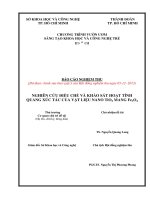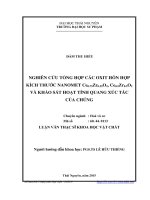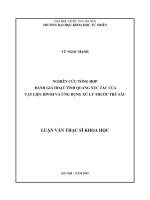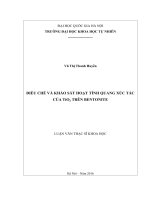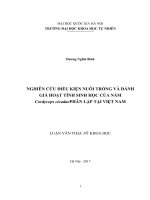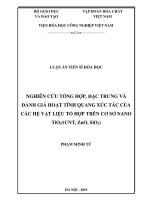Nghiên cứu tổng hợp, đặc trưng và đánh giá hoạt tính quang xúc tác của các hệ vật liệu tổ hợp trên cơ sở nano TiO2(CNT, ZnO, SiO2) ttta
Bạn đang xem bản rút gọn của tài liệu. Xem và tải ngay bản đầy đủ của tài liệu tại đây (2.32 MB, 28 trang )
MINISTRY OF EDUCATION AND TRAINING VIETNAM NATIONAL CHEMICAL GROUP
VIETNAM INSTITUTE OF INDUSTRIAL CHEMISTRY
--------------------------------------------
PHAM MINH TU
STUDY ON SYNTHESIS, CHACRACTERIZATION AND
EVALUATION OF PHOTOCATALYTIC ACTIVITY OF NANO
TIO2/(CNT, ZnO, SiO2)
Major: Theoretical Chemistry and Physical Chemistry
ID: 9.44.01.19
THESIS SUMMARY
HANOI -2019
1
2
This thesis is completed in Viet Nam Institute of Industrial Chemistry
Advisors:
Prof. Vu Thi Thu Ha – Viet Nam Institute of Industrial Chemistry
Reviewer 1: Assoc. Prof. Dang Tuyet Phuong – Vietnam Academy of Science and
Technology
Reviewer 2: Assoc. Prof. Nguyen Thanh Binh - VNU University of Science
Reviewer 3: Assoc. Prof. Nguyen Manh Tuong - Military Science Academy
This thesis is defended at the Institute-level Judging Council in Vietnam
Institute of Industrial Chemistry:
At: 9 h 00 Date 31 Month 12 2019
Viet Nam Institute of Industrial mistry’s dissertation committees
The thesis can be accessed at:
The National Library of Viet Nam
The Library of Vietnam Institute of Industrial Chemistry
3
A - INTRODUCTION
1. Reason for choosing the subject
Recently, we are facing the threat of environmental pollution and infectiuous
disease outbreak caused by emission from industrial zone, plants producing
chemical, fertilizer or dye, thermal power plants, food processing plants, etc.
that pollutes water, land and air. Solutions to these problems often require
enormous cost and may even cause secondary pollution. Therefore, research
into the production of effective materials in processing environmental
pollutants is very urgent.
Photocatalytic materials are currently being considered as an effective
solution to the above problems. TiO2 is known as an ideal semiconductor for
photocatalysis as it is a non-toxic metal oxide with high photochemical
activity, low cost, chemical resistance, high refractive index, no
photochemical corrosion. At the same time, TiO2 catalysis happens under
normal temperature and pressure, post-reaction catalysts can be recovered
and reused easily. The products of the process are CO2, H2O or non-toxic
organic compounds. With these advantages, TiO2, especially nano TiO2, has
attracted the attention of scientists in the country and in the world.
However, for TiO2 catalysts, only ultraviolet radiations corresponding to
photons with energy greater than 3.2 eV (band gap energy of titanium
dioxide) are absorbed to produce photochemical effects. Therefore, only
ultraviolet radiation, which accounts for only about 4% of solar radiation, is
effective. In addition, the recombination of photogenerated holes and
photogenerated eletrons occurs very fast (from 10-12 to 10-9 seconds), which
is also a drawback when deploying photocatalytic systems on the basis of
TiO2. In order to solve the above problem, we need to produce nanosized
TiO2 with reasonable size and structure, and combine TiO2 with other
components to limit the possibility of recombination of photogenerated
holes and photogenerated eletrons and enhance photochemical activity in the
visible light region.
2. Objectives
The thesis is aimed at creating a catalyst material with high photocatalytic
activity which is simply synthesized from available raw materials. The new
kind of catalyst material is expected to meet the following requirements:
- High photocatalytic activity, effective treatment of pollutants;
4
- Simple preparation, from available raw materials, low cost;
- Ability to work efficiently and stably in visible light region;
- Ability to work flexibly in both interrupted and continuous reaction
systems, as well as self-cleaning coatings.
3. Scientific and pratical meanings
The thesis is aimed at studying the developing photochemical catalysts
based on highly active nano TiO2 which are simply prepared from available
raw materials, effective in pollutant treatment and capable of flexible
application on interrupted and continuous reaction systems. Specifically:
- Preparation of TiO2 nanotubes from a variety of materials including
commercial TiO2 which is available on the market by simple hydrothermal
methods;
- Combination of TiO2 nanotubes and materials with photochemical activity
in visible light region based on carbon nanotubes (CNTs), ZnO, SiO2;
- Synthesize TiO2 sol and apply to the surface of glass material by dipcoating method, using SiO2 sol-gel.
- Evaluation of photo-oxidation activity of catalysts by using methylene blue
as a model reactant;
- Design and manufacture of work equipment in continuous current mode,
using sunlight.
4. Innovations and creativities
- The synthesis of TiO2 nanotubes from commercial TiO2 by one-step
dynamic hydrothermal method has been systematically studied, proposing
tube forming mechanisms. This is a simple and effective method that allows
the synthesis of TiO2 nanotubes of uniform quality;
- A complex of catalyst materials has been successfully synthesized based
on TiO2 nanotubes and carbon nanotubes MWCNTs, demonstrating the
"synergistic" effect between the two components of MWCNTs and TNTs,
reducing the recombination between photogenerated eletrons and
photogenerated holes;
- The appropriate mass ratio of MWCNTs/TNTs for the MWCNTs/TNTs
catalyst system has been determined as 1/1. The catalyst system has a high
and stable photochemical activity in the oxidation of H2S. At the same time,
this catalyst has high sulfur selectivity, reaching 100% in the first 200
minutes of reaction;
5
- The synthesis of catalyst system based on TiO2 sol/SiO2 by dip-coating
method has been systematically studied. The catalyst is highly active,
opening the direction for applying photochemical catalysis based on nanoTiO2 sol on the self-cleaning surface.
5. Thesis's structure
The thesis consists of 148 pages, divided into the following sections:
Introduction: 02 pages; Overview: 38 pages; Experimentation: 18 pages;
Results and Discussion: 77 pages; Conclusion: 02 pages; Innovations and
creativites: 1 page; List of projects that have been published: 01 page;
References: 9 pages (including 116 references). The thesis has 12 tables, 93
drawings and graphs.
B - MAIN CONTENTS OF THE THESIS
Chapter 1 - LITERATURE REVIEW
This section provides an overview of TiO2-based photochemical catalysis,
methods for synthesis of nanomaterials applied to photochemical catalysis
on the basis of TiO2 and denaturing substances, wastewater treatment
technologies which focus on wastewater in the laundry detergent industry.
Chapter 2: EXPERIMENTATION
The experimentation was carried out at National keylaboratory for
petrochemical and refining technologies
2.1. Synthesis of catalysts
a. Synthesis of TiO2 nanotubes
Two methods for systhesis of TiO2 nanotubes have been investigated
- TiO2 nanoparticles are synthesized from a number of different Ti sources
such as Ti(OC3H7)4, Ti(OC4H9)4, TiCl4; TiO2 nanotubes are synthesized
from TiO2 nanoparticles.
- TiO2 nanotubes by one-step synthesis method using commercial TiO2
particles.
b. Synthesis of TNTs/MWCNTs catalysts
MWCNTs are surface-activated with a mixed solution of HNO3: H2SO4
before both MWCNTs and commercial TiO2 are dispersed in 10M NaOH
solution (99%, China) with different mass ratios of MWCNTs/TNTs.
c. Synthesis of nano TiO2 material on carriers
- TNTs/ZnO powders are prepared by directly put TNTs into the synthesis
of ZnO-NF/ZnO-TM complex at a varying mass ratio.
6
- TiO2/SiO2 catalysts are synthesized from TiO2 sol and SiO2 sol.
2.2. CHEMICAL PHYSICS CHARACTERIZATION
Using XRD, TEM, SEM, BET methods, dynamic light scattering, PL, UV
and IR fluorescence to characterize the properties, structure and particle size
of catalysts.
2.3. Shape the catalysts
Cylinder formation includes mechanical mixing of binders and catalysts and
adding enough water, then tempering the mixture to increase the effect of
binders. The tempered mixture is pelleted on the extruder KBV-VV-400-TH
of National keylaboratory for petrochemical and refining technologies.
2.3. CATALYTIC ACTIVIY STUDY
Catalytic activity is assessed through the photodegradation of methylene
blue (MB) as a model reactant. The methylene blue solution is mixed with
distilled water at different concentrations.
After a preliminary investigation with the model, the catalyst is evaluated
for activity with actual wastewater. The actual wastewater obtained from a
laundry detergent plant contains surfactants, typically linear alkyl sulfonate
(LAS) anionic surfactants, which have been pretreated by physical and
chemical methods, with COD in the range of 150-250 mg/l.
The organic matter content in wastewater before and after treatment is
analyzed by the total organic carbon (TOC) measurement.
7
Chapter 3: RESULTS AND DISCUSSION
3.1. SYNTHESIS OF TIO2 NANOTUBES
3.1.1. Effects of raw materials
Ti(O-C3H7)4
Ti(O-C4H9)4
TiCl4
TiO2 thương mại
Fig 3.1. TEM images of TiO2 nanotubes which are fabricated from
different materials
Thus, through the study of effect of raw materials for the synthesis of TNTs.
The result showed that, the process of synthesizing TNTs from TiO 2
commercial is the simplest and cheapest. The products TiO2 get evenly size,
high quality equivalent to TiO2 nanotubes is obtained from other expensive
precursors or other method. So, TiO2 commercial is chose for the next
researchs.
3.1.2. Effect of conditions reaction
NaOH 5M
NaOH 7M
8
NaOH 10M
NaOH 15M
Fig 3.2. TEM images of TNTs which is synthesized with different
concentration of NaOH
So, 10M is the suitable concentration for synthesis process, will be chose for
the next research.
900C
1100C
1300C
1500C
Fig 3.3. TEM images of TNTs which are synthesized with different
temperature
130oC is the temperature suitable concentration for synthesis process
9
Fig 3.4. TEM images of TNT which are synthesized by different time
reaction: (a) 0h; (b) 1h; (c) 3h; (d) 5h và (e) 7h
3h is the reation time which is suited to concentration for synthesis process.
Fig 3.5. TEM images of TNTs before (a) and ater (b) treating by acid
The result showed that, the sample without treat by acid is almost inactive
photochemical whereas the sample treat by acid is high photochemical
activity. Thus, processing by axit impact significantly on photocatalytic
properties of TiO2 nanotubes.
3.1.3. Formation mechanism of TNTs
Dissolution of TiO2 precursor:
TiO2 + 2 NaOH → 2Na+ + TiO32- +H2O (1)
Dissolution–crystallisation of nanosheets
2Na+ + TiO32-→ [Na2TiO3] nanosheets (2)
Curving of nanosheets
2Na+ + TiO32-+ [Na2TiO3] nanosheets → [Na2TiO3] nanotubes (3)
Washing of nanotubes
[Na2TiO3] nanotubes + 2H2O → [H2TiO3] nanotubes +2 NaOH (4)
[TiO2] nanotubes
10
3.2. SYNTHESIS OF PHOTOCATALYST BASED ON TiO2
NANOTUBES
3.2.1. Synthesis of catalysts MWCNTs/TNTs
Table 3.1. Specific area (SBET) of catalysts MWCNTs/ TNTs
Samples
Specific area (SBET), m2/g
TNTs
311,44
1/10 MWCNTs/TNTs
270,32
1/1 MWCNTs/TNTs
242,31
2/1 MWCNTs/TNTs
188,25
MWCNTs
152,48
Fig 3.6. TEM images of catalysts MWCNTs/TNTs: (a) TNTs, (b)
MWCNTs, (c) 1/10 MWCNTs/TNTs, (d) 1/1 MWCNTs/TNTs,
Fig 3.6. (e) 2/1 MWCNTs/TNTs
11
Fig 3.7. HRTEM of catalyst 1/1 MWCNTs/TNTs
Fig 3.8. FTIR spectra of TNTs, MWCNTs và MWCNsT/TNTs
Fig 3.9. XRD patterns of (a) MWCNTs; (b) TNTs; (c) 1/10
MWCNTs/TNTs và (d) 1/1 MWCNTs/TNTs
12
Fig 3.10. UV-VIS-DRS spectra of catalysts MWCNTs/TNTs
Table 3.2. Band-gap values of the synthesized photocatalysts
(Kubelka-Munk model)
catalyst
Band gap (eV)
TNTs
3,26
1/10 MWCNTs/TNTs
3,21
1/1 MWCNTs/TNTs
3,08
2/1 MWCNTs/TNTs
3,05
MWCNTs
-
Fig 3.11. PL spectra of catalysts MWCNTs/TNTs
13
3.2.2. Synthesis of TNTs/ZnO
6000
5000
Lin (Counts)
4000
3000
2000
1000
0
10
20
30
40
50
60
70
2-Theta - Scale
File: 0104801ZnO.raw - Type: 2Th/Th locked - Start: 10.000 ° - End: 80.019 ° - Step: 0.011 ° - Step time: 18.9 s - Temp.: 25 °C (Room) - Time Started: 10 s - 2-Theta: 10.000 ° - Theta: 5.000 ° - Chi: 0.00
Operations: Smooth 0.150 | Import
01-071-6424 (A) - Zincite, syn - ZnO - Y: 94.05 % - d x by: 1. - WL: 1.5406 - Hexagonal - a 3.24940 - b 3.24940 - c 5.20380 - alpha 90.000 - beta 90.000 - gamma 120.000 - Primitive - P63mc (186) - 2 - 4
Fig 3.12. XRD patterns of ZnO
Fig 3.13. SEM images of ZnO
Hình 3.14. UV-Vis spectra of TiO2/ZnO
14
80
Fig 3.15. PL spectra of catalysts TNTs, TNTs/ZnO và ZnO
Table 3.3. Effect of ZnO content in nanocomposite TNTs/ZnO
STT
ZnO content in TNTs/ZnO
1
100
2
0
3
90
4
80
5
70
Shape the catalyst TNTs/ZnO
conversion MB after 30
min (%)
55
85
89
89
89
Inherited other reseachers, pseudo-boehmit is chose such as binder for
shaping catalysts TNTs/ZnO with 12% weight content. The results showed
that pellet TNTs/ZnO has the specific surface area 108,5 m2/g; Mechanical
robustness reached 50 N/cm2. Catalyst has high mechanical robustness
because attendance of pseudo-boehmit and ZnO-NF/ZnO-TM such as good
binders
Mechanical robustness measure results of catalyst after dipping few days in
water is showed in Tab. 3.4.
Table 3.4 . Mechanical robustness measure results of catalyst
Time (day)
Mechanical robustness (N/cm2)
0
50,00
4
48,93
10
45,33
20
43,05
30
39,77
15
Results of photocatalytic activity test in MB degradation reaction showed
that the catalysts has high activity photochemical with 95,3% to 97,2% in 50
min reaction.
3.2.3. Synthesis of TiO2/SiO2
The combination of TiO2 and SiO2 not only enhances TiO2 photochemical
activity, but also enhances the physical properties of the catalyst such as
Mechanical robustness, transparent.
a. Synthesis of sol silica
Fig 3.16. Partical size of sol silica: [Si]=0,4M, pH=8,
Temperature: 60oC
Fig 3.17. TEM image of sol silica when: (a) without surfactant, (b)
PEG 1000, (c) PVP K30
b. Synthesis of sol TiO2
Morphology and structure of partical in sol TiO2 are illustrated in fig. 3.18.
(a)
Sample C%TiO2=0,6%
(b) Sample C%TiO2=0,7%
16
(c) Sample C%TiO2=0,8%
Fig. 3.18. Morphology and structure of partical in sol TiO2: a - 0,6%; b 0,7%; c - 0,8%
Concentration 0,7% is chose for the next research
Table 3.5. Effect of pH of gel Ti(OH)4 to end product
pH
3
4
End products
pH
No gel
7
Gel, yellow,
8
transparent
5
Gel, yellow,
9
transparent
6
Gel, yellow,
10
transparent
Thus, pH= 8 is chose for the next research.
End products
Sol, transparent
Sol, transparent
(stable)
Sol, transparent
Sol, transparent
Sol TiO2 which is synthesized at those suitable conditions, is evaluated
photocatalytic activity in photooxidation MB reaction under radiation solar,
the results were showed in fig. 3.59.
Độ chuyển hoá MB (%)
100
80
60
40
20
0
0
20
40
Thời gian phản ứng (phút)
60
80
Fig. 3.19. Photocatalytic activity of coating TiO2
17
The results from fig. 3.19 showed that, coating TiO 2 can degraded 70%
methylene Blue in 20 minutes and degraded completely MB in 1 hour
(conversion 99%).
Catalyst TiO2/SiO2 was fabricated on substrate which is glass rod with
100mm x 20mm x 2mm by dip-coating method. XRD patterns of SiO2, TiO2,
and catalyst TiO2/SiO2 after calcinating at 500oC in 30 min were showed in
fig. 3.20.
Hình 3.20. XRD patterns of SiO2, TiO2, and TiO2/SiO2 after
calcinating at 500oC in 1 hour
Hình 3.21. FTIR spectra of TiO2/SiO2 is recorded at 4.000 - 450 cm-1
FTIR spectra of TiO2/SiO2 given full information about bonds of
components in nanocomposite catalyst. In other words, TiO2 have fixed
successfully on substrate SiO2.
Photocatalytic activity of catalyst TiO2/SiO2 is showed in fig.3.22
18
Độ chuyển hoá MB (%)
100
80
60
40
20
0
0
20
40 phản ứng
60 (phút)80
Thời gian
Fig 3.22. Photocatalytic activity of catalyst TiO2/SiO2
The results showed that, MB is almost degraded completely in 60 minutes.
That means, The results showed that, MB is almost degraded completely in
60 minutes. That means, SiO2 attendation in catalyst TiO2/SiO2 that
improved partly photocatalytic activity of catalyst.
The results are completely suitable with UV-Vis spectra of TiO2/SiO2 that
were illustrated in Fig. 3.23.
Hình 3.23. UV- Vis spectra of catalyst TiO2/SiO2
UV- Vis spectra of TiO2/SiO2 showed that the combination of TiO2 and SiO2
caused wide-open of absorb solar radiation which tend absorb of red
radiation.
3.2.4. Synthesis of sol TiO2-SiO2
Fig. 3.24. TEM images of sol: (a) sol SiO2, (b) sol TiO2, (c) sol SiO2TiO2
19
Results of photocatalytic activity of SiO2-TiO2 test in MB degradation
reaction were illustrated in Fig. 3.25.
Độ chuyển hoá MB (%)
100
80
60
40
20
0
0
20
Thời 40
gian phản60
ứng (phút)
80
Fig. 3.25. Photocatalytic activity of sol TiO2-SiO2
The result from fig.3.25 showed that, TiO2-SiO2 coating can degraded 70%
methylene Blue in 20 minutes and degraded completely MB in 1 hour
(conversion 99%).
3.3. EVALUATE CATALYTIC ACTIVITY OF CATALYSTS
3.3.1. Evaluation of photocatalytic activity on photodegradation
Methylene blue reaction
Photocatalytic activity of catalysts MWCNTs, MWCNTs/TNTs, TNTs, và
TNTs/ZnO have evaluated by photodegradation reaction of methylene blue
(batch model). The results showed in fig. 3.26
Fig. 3.26. Photocatalytic activity of catalysts
Photocatalytic activity of TNTs has great performance when it's combined
with MWCNT or ZnO. Especialy, catalyst MWCNTs/TNTs 1:1 can
degraded MB 90% in 20 min. The results showed again, the combination of
TNTs and MWCNTs is very effective. It can be applied in catalytic and
environment field.
20
3.3.2. Investigation of photocatalytic activity of MWCNTs/TNTs 1/1 in
photooxidation H2S reaction.
The conversion and selectivity of H2S were recorded when it was test on
catalyst 1/1 MWCNTs/TNTs in oxidation H2S reaction . The results were
compared wiht catalyst TNTs. The comparison results were shown on fig.
2.27
Fig. 3.27. Convertion and selectivity of photooxydation H2S reaction
on catalyst 1/1 MWCNTs/TNTs and TNTs
The conversion of H2S and selectivity of sulfur were shown on fig. 3.28
and fig. 3.29.
100
Độ chuyển hoá H2S (%)
90
80
1/10
MWNTs/TNT
70
60
50
40
0 100 200 300
400gian
500 600
700ứng
800 9001000
Thời
phản
(phút) 1100
Fig. 3.28. Conversion of H2S
100
Độ chọn lọc lưu huỳnh
(%)
90
80
70
60
50
1/10
MWNTs/TNT
40
0 100 200 300 400 500 600 700 800 900 10001100
Thời gian phản ứng (phút)
Fig. 3.29. Selectivity of sulfur
21
Thus, catalyst MWCNTs/TNTs with ratio MWCNTs/TNTs = 1/1 were show
more stable performance than the others catalyst.
3.4. STUDY ON PHOTOCATALYTIC DEGRADATION OF MB BY
CATALYST TNTs/ZnO USING CONTINOUS-FLOW REACTION
SYSTEM
3.4.1. Effect of reaction time
The results were showed in fig.3.30. The conversion reached 100% when
flow-rate below 6.300 mL/h.
Fig. 3.30. Effect of flow-rate
3.4.2. Effect of temperature
The results showed that, the conversion wasn’t almost changed then
temperature changed from 20 to 40oC.
Fig. 3.31. Conversion of MB at different temperatures
3.4.3. Effect of pH
The results on Fig.3.32 showed that, the conversion reached max at pH=7.
22
Fig. 3.32. Effect of pH value
3.4.4. Evaluate durability of catalyst
The result showed that, photocatalytic activity of catalyst was durability in
long time. After 30 days, the conversion of MB was only decreased 4%.
Thus, catalyst is almost durability phototcatalytic activity.
Fig. 3.33. conversion of MB in 30 days
3.4.5. Research on catalyst regeneration method
Water was went through the catalyst with same flow-rate of MB 6300 ml/h.
Turn on the lamb to regenerate catalyst. The results were showed in fig. 3.34.
Fig 3.34. Effect of time regeneration of catalyst
23
3.5. SUTY ON PHOTOCATALYTIC DEGRADATION OF WASTE
WATER CONTAIN SURFACTANTS USING CONTINOUS-FLOW
REACTION SYSTEM
Table 3.6. Specifications of waste water which contain organic
compound before treating by photochemical process
Specifications
Unit
Result
3
4
COD
TOC
mg/l
mg/l
207
52,6
COD đầu ra, mg O/l
STT
100
80
60
40
20
0
5700
5800
5900
6000
6100
6200
6300
Lưu lượng dòng, ml/h
Fig 3.35. Effect of flow-rate to index COD
COD đầu ra, mgO/l
50
40
30
20
10
0
15
20
25
30
35
40
Nhiệt độ phản ứng, ºC
COD đầu ra, mgO/l
Fig 3.36. Index COD at different temperature
100
80
60
40
20
0
2
4
6
8
10
Giá trị pH
Fig. 3.37. Effect of pH to index COD of water
24
Table 3.7. Specifications of water after treating
by photochemical process
No
Specifiactions
Results
2
TOC, mg/l
12,6
3
COD,mg/l
48,8
The results on table 3.7 showed that, total organic chemical in water after
treating by photochemical process were decreased significantly from 52,6
mg/l to 12,6 mg/l that means 76% of organic chemical were reduced by
photochemical process, using catalyst TNTs/ZnO. In other words, catalyst
TNTs/ZnO can degradated efficaciously organic chemicals in waste water
which contain surfactants.
25

